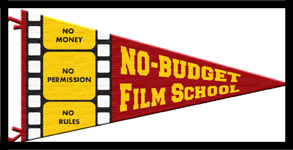|
 |
|
| "Pig" starring Rudolf Martin |
When you teach no-budget filmmaking and then you a make no-budget feature, there's
a lot of added pressure on you. Yeah, you have to get the film made, which is trying enough, and for a lot of first-time
filmmakers, that is the big accomplishment. When you've made a few, especially if you've been successful on some of them,
then the bar is raised higher--you have to make a great film. If you've made a few films, especially with limited
resources, you know how hard that can be. I would say it is just about impossible, with equal amounts of skill, experience,
passion, luck, magic juju, and probably a few mystical things I haven't discovered yet, needed to make it possible. But
when you teach no-budget filmmaking, and arrogantly consider yourself an "expert" in no-budget filmmaking, the bar is raised
even higher--now you've got to get the movie made, it has to be great, and you HAVE to do it for no money, even if you live
in Los Angeles, (where most movie-making things cost money), and even if you don't necessarily have a no-budget project.
THE NO BUDGET WAY
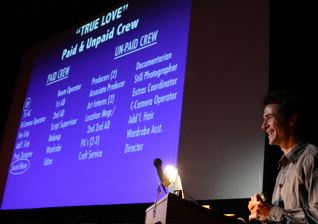
|
| No Budget Film School |
This last little caveat--the no-budget project--is what the first day of my class is all about. I've always felt very strongly about this idea--designing a project from your own unique set of limitations
and resources--and have tried to impress it upon my students, despite my sense that that's not what they paid $200-$300
to hear. They want me to tell them how to make the film in their back pocket, the one that wasn't designed around their resources
(or lack of them), and for this reason, I sense they enjoy the lessons from Day Two much more, where I tell them how to save
money on standard movie-making things and give them a sense of the risks they're taking by not spending the normal amounts
people spend on things like production insurance, or SAG actor salaries, etc.
Well, when I show up on May 30th and do my bit about taking that script in your back pocket and putting it on the shelf, and coming up with a brand new project
catered to your specific situation, I will do it with a renewed sense of passion and vigor. This is precisely how you make
a good no-budget film and it is also the way to enjoy making a no-budget film. Nothing teaches you that more than doing it
the other way. The way we did it on "Pig," the no-budget film I just finished shooting.
LEARNING LESSONS FROM A PIG
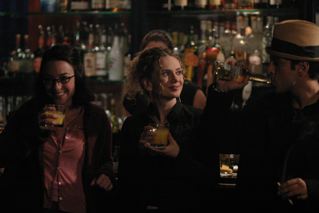
|
| "True Love" scene in friend's bar |
I know, I should never admit anything like this, and I'm not saying that the
film won't be a good one--it's much too early to say and at this point, I am actually very excited about its prospects. The
point I'm trying to make is that no matter who you are and what you know about making films for no money, if you don't work
from available resources, and embrace your limitations, you are in for a difficult haul. Yeah, I knew this, but I guess I
got cocky. With my last feature, "True Love," we pulled several miracles out of our butt, which I certainly had planned to do this time, and did do. But we also took
a $2 million budgeted script and re-wrote it for what we had, for the most part. Especially locations. All the filmmakers--the
director, my producing partner, and myself--opened the doors of our homes up to the "True Love" shoot, and close friends were
cajoled into doing the same. (BTW, this is usually a one-time thing--a get out of jail free card you can only use once).
"Pig" just wasn't this kind of script, and here's where the trouble started.
IT ALL STARTS WITH LOCATION
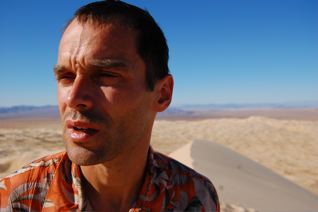
|
| Shooting "Pig" in the Mojave Desert |
To pull off a smooth-running shoot, especially a no-budget shoot, you have to
lock down locations with enough time to coordinate and schedule everything else around them. You can't lock down cast and
crew schedules, order up equipment, and put together the myriad of other things, if you don't have anywhere to shoot. A camera
assistant can be found the night before, an 8-day location can not. If you don't have the money to pay the going Los Angeles
rate for a 1920's Apartment, or a Large Fancy Conference Room, then it is going to take time (and maybe a miracle, pulled
out of your butt) to find these places for no-money. Making films The No Budget Way, you're supposed to already have
these places and then write them into your script, not the other way around. So you're trying to coordinate a ton of other
elements, namely people's schedules, without the certainty that you will have the place to shoot. Three things happen in
this situation: 1.) you find that miracle, and pull it out of your butt; 2.) you don't find that location, and you either
push the shoot (or that portion of the shoot), or you compromise with something you can afford; or 3.) you pony up the money
necessary to secure the location and shoot your damn movie. With "Pig," we did all three, though as far as ponying up the
money, that was only done within certain shallow-pocketed limitations. I just don't have the cash or the gall to pay someone
$2500/day for a location, which is considered cheap around here. I feel great about the butt-pulled miracles (I think it's
time to retire this metaphor), and I don't think we made any compromises that screwed the film. What's killing me is the
extra money spent. YOU don't have to worry, perhaps, about going over budget--if you have or can find the money, then
you did what you had to do to make the film great (or get it made), but ME, the no-budget filmmaking MAVEN, that is not permissible.
The first Write It Down Rule in my class is "Refuse To Spend Money"; I'm already breaking my own rules here!
THE DP IS THE MOST INFLUENTIAL MEMBER OF YOUR CREW
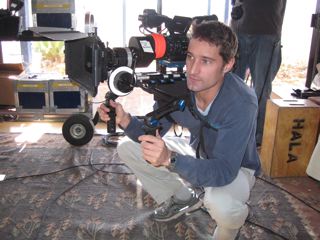
|
| DP Collin Brink w/ tricked out Sony EX1 |
This is another topic I discuss in my class, and I take a rather controversial
position on it. I didn't say above that the DP was the most important position. They, the DP, will undoubtedly think
that, but you the producer can not be swept away by the idea that it's all about the visuals. Sure visuals are important,
and more so with some projects than others, but you're responsible for every other department, and all the things that happen
in post and beyond, like marketing the film and delivering it to a distributor, and you have to realize that within that context,
the visuals are just a small piece of the pie (or puzzle, more accurately). Take my class for a lengthy explanation of what
I believe is almost always more important, but the reasons why the DP is the most influential position are several.
First, they determine what your equipment needs are going to be. You may have purchased a prosumer camera to shoot
your film with, but if they don't want to shoot with that camera, then you are either going to spend more money on what they
prefer, or struggle daily with an unhappy cinematographer. They're going to choose the camera, format, camera gear, and grip
and lighting gear, and while you won't want to give them free reign on these decisions, the middle ground you agree on will
be different with different DP's. Second, they determine your crew needs. Yes, you can insist on one G&E and no camera
assistant, but if they don't want to--or can't--work that way, then your film will suffer. Third, they determine the speed
of your shoot, for the most part. You may want to shoot your 120 page script in 10 days without going over 12 hours per
day, but it really doesn't have anything to do with what you want. You're either going to make your days or you're not, and
the DP (along with the director and even the AD to some extent) will be incredibly influential in that process. If you haven't
figured it out yet, these three determinations all affect to an enormous extent the cost of your production. If you have
a no-budget plan about what kind of camera you're going to shoot with, what kind of gear you're going to need to light things,
the size of your crew, and the speed with which you shoot, but you find a great DP with different ideas, then you're going
to either adjust your no-budget plan or you're going to have to find another DP. On "Pig" we found a wonderful, talented
DP with a different plan. Because we were boxed into a scheduling corner due to our locations, we didn't have time to find
a wonderful DP with the same plan, so the plan changed. And it got more expensive. Does the film look great? Absolutely!
Do I have a lot of money left over for re-shoots and such? Fuck no. These are the decisions and considerations a producer
has to make when they're trying to get the film in the can, and still have something good enough to pull out of the can.
LEVERAGE EVERYTHING YOU CAN
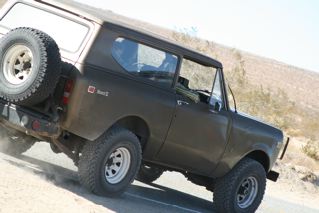
|
| 1971 Scout ("The Beast") |
There are some lessons from my class that I only reinforced on this film.
Leverage is a concept I discuss quite a bit over the two days. You leverage the cash resources you have to cover things
you don't have, you barter equipment and services you have for things you don't have, and you lean on friends and family
and beg, borrow and steal from them. This works, people! This is how you make a movie with no money. I give several examples
of this in my class, but I will discuss a couple here. We needed a very particular vehicle for several days of shooting--specifically,
a 1970's or 1980's Bronco, Blazer, or Scout type SUV. I had no money to rent one and it would have been difficult (and no
doubt expensive) to find one to rent anyway, without going to one of the big Hollywood studio vehicle rental places. How
did we get it? I reached out to friends, asking if they knew anyone with this kind of vehicle, and then I bartered my car
(a once-amazing, but still hanging-in-there 1998 BMW M3 convertible) for the SUV. A friend suggested a neighbor who owned
a perfect 1971 International Harvester Scout, and he was up for the trade. We got a lot of production value out of what was
essentially a free piece of equipment. Another example: we shot with the Sony EX1 HD camera, (which we own and I highly recommend). We wanted to shoot with two cameras and we also wanted more SxS cards (the expensive
memory cards you shoot on in lieu of tape), but we didn't want to pay for any of that. Because we owned one, we were able
to barter for the other, and not only the other camera, but more cards and batteries. This saved us a lot of money over the
long haul.
OTHER LESSONS TO MENTION
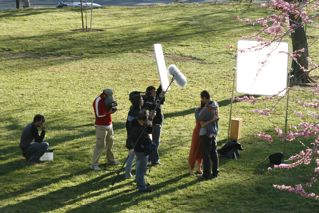
|
| Shooting in the park--no permit |
So what other things did I learn from this shoot, or re-learn, as the case may
be? Good sound is more important than good visuals in most instances--another slide in my class. A wonderfully lit,
incredibly well-acted scene is probably unusable if you don't get good production sound. Acting is everything. A
good performance will save your scene, and your film, if all else goes wrong. You want to create an atmosphere where good
performances happen. These environments may be different for different actors and projects, but generally, you want to
give your director the time to work with the actors, and you want to put them in a situation where they can be comfortable
finding what's best for the scene. That means that if you are stealing a park location and even though you have a full-proof
plan for alerting the set if a park ranger shows up, everyone is freaked out anyway that you're going to get busted, then
you're going to have to find a better place to shoot that scene.
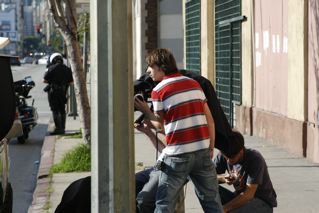
|
| Shooting downtown--no permit |
That example aside, I'm still a big believer in you don't need a permit to
shoot in Los Angeles. We shot all over the place--suburban streets, downtown in front of office buildings and tenement
hotels, aforementioned parks, inside motel rooms and apartments--all without a single filming permit. Hey, that's how I roll.
You also want to design your film access-wise and money-wise to be able to re-shoot scenes that don't work, or after
editing, go out and shoot inserts that will enhance the cut and make it sing. If you don't own the camera or can never get
the lead actor back again, these options will not be possible. This is something I feel very strongly about and we made sure
to cast someone who was willing to work that way.
These are just a few of my thoughts about no-budget filmmaking as I sit back and reflect on what we've just done. And we're
still editing, with a few more days of shooting that we still owe. We're basically at the 5 yard line of a 100 yard dash
at this point. There will be more lessons to glean from this experience for future Reports, or future classes.
ARCHIVED EDITIONS OF THE NO BUDGET REPORT:
|
